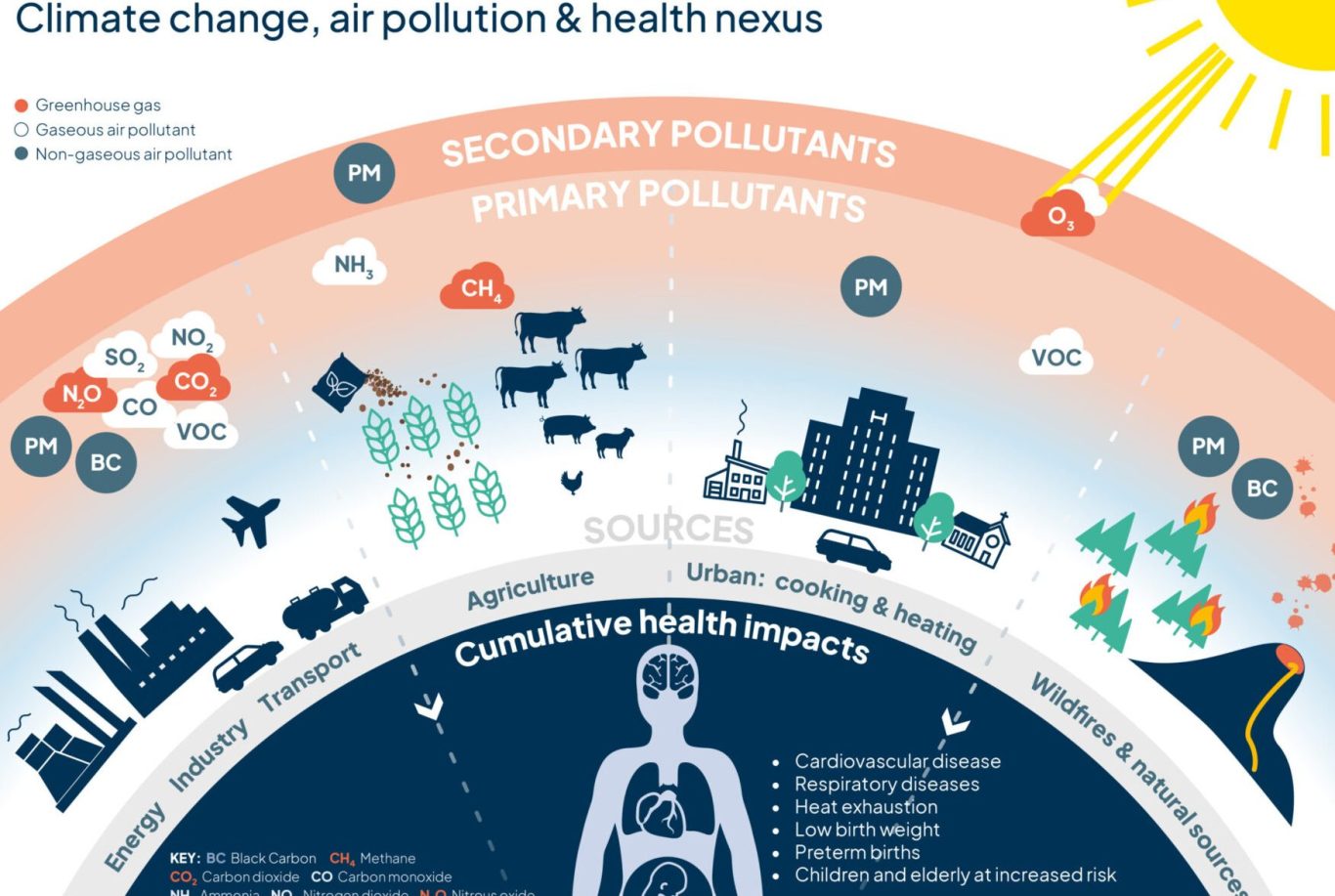Climate Change and Indoor Air Quality

The connections among climate change, air pollution, and health. (Source: Centre for Climate Engagement, University of Cambridge, UK)
Addressing indoor air quality is crucial for overall health, especially given the undeniable reality of our changing climate. The World Health Organization highlights that the dangers associated with poor air quality are increasing year by year.
Historically, in the UK, air pollution was primarily due to the burning of fossil fuels for heating and industry. The first comprehensive study of air pollution was conducted in London in 1661 and this detailed the adverse effects of coal smoke on health, plant life and buildings.
The infamous deadly smog of London in 1952, which lasted five days, resulted in 12,000 deaths and a significant increase in bronchitis cases across all age groups. This became a turning point and led to The Clean Air Act of 1956 which initiated a national survey to monitor air quality, including black smoke and sulfur dioxide. This monitoring then developed into the Control of Pollution Act in 1974, which set limits on pollutants.
Since then, the focus has shifted to vehicle pollution. The Environment Act of 1995 supported enforcement and led to the publication of the UK Air Quality Strategy targeting eight pollutants from vehicles. Local governments were required to produce action plans to reduce pollution levels in designated regions. This involved setting up outdoor stations in high-traffic areas with diffusion tubes. However, local governments are not mandated to monitor indoor air quality in homes or buildings. Further, monitoring stations are generally placed much higher than human breathing zones and are influenced by climatic variations; it is now indisputable that air pollution impacts climate change, which in turn affects our entire environment and the air we breathe indoors.
Disruptions to weather patterns lead to increased concentrations of pollutants such as particulate matter, smoke, dust and ground-level ozone. These changes also affect the production, distribution and severity of airborne allergens. Additionally, climate-related shifts can raise humidity and heat levels, promoting mould growth and other allergens, which compromise air quality in schools.
It is essential to recognize that indoor air pollution can be up to five times (and occasionally 100 times) worse than outdoor pollution. Surprisingly, young people spend an average of just 68 minutes outdoors per day. Certain groups (including individuals with asthma or compromised immune systems) are particularly vulnerable to the effects of poor indoor air quality. Children are especially at risk due to their faster breathing rates and developing bodies.
Plants and trees act as filters; reducing pollution in and around schools. Plants absorb carbon dioxide; a gas that would otherwise build up, increase temperatures and make it difficult for people to breathe. But due to climate change, CO₂ will continue to rise further, which will make it even harder to get levels down within classrooms by opening just windows, and higher CO₂ also increases how long viruses like SARS-CoV-2 remain viable in the air.
The Clean Air (Human Rights) Bill

The Safe Air Schools Foundation supports the Clean Air Bill.
If successful, this Bill would make breathing clean air a human right and require the government to establish a commission that would oversee government action on air pollutants.
The Bill also amends the Environment Act 2021 to incorporate missing elements such as air quality target limits in line with WHO guidelines. This is desperately needed considering most schools in the UK are in areas above the WHO recommended levels. It is recommended that the commission pay particular regard to the needs of especially sensitive groups such as children in setting their target limits, including indoors and on public transport.
Clean Air Bill Summary
- To make provision for reducing indoor and outdoor air pollution, including greenhouse gases
- To set minimum standards for air quality in workplaces, homes and public spaces
- To require the monitoring of air quality
- To require the Secretary of State to publish a strategy for reducing air pollution, including setting targets and measures for air quality, and to report to Parliament annually on the implementation of that strategy
- To give powers to the Office for Environmental Protection to enforce legislation relating to air quality and the reduction of greenhouse gas emissions
- To make provisions to reduce pollution from vehicles
- To place a duty on the Secretary of State to encourage and facilitate forms of active travel and to publish a strategy for reducing emissions from transport

We need your consent to load the translations
We use a third-party service to translate the website content that may collect data about your activity. Please review the details in the privacy policy and accept the service to view the translations.
